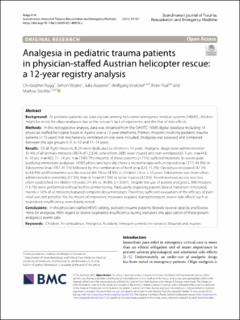| dc.contributor.author | Rugg, Christopher | |
| dc.contributor.author | Woyke, Simon | |
| dc.contributor.author | Ausserer, Julia | |
| dc.contributor.author | Voelckel, Wolfgang | |
| dc.contributor.author | Paal, Peter | |
| dc.contributor.author | Ströhle, Mathias | |
| dc.coverage.spatial | Austria | en_US |
| dc.date.accessioned | 2021-12-07T10:08:21Z | |
| dc.date.available | 2021-12-07T10:08:21Z | |
| dc.date.created | 2021-12-02T16:36:09Z | |
| dc.date.issued | 2021-11 | |
| dc.identifier.citation | Rugg, C., Woyke, S., Ausserer, J., Voelckel, W., Paal, P., Ströhle, M. (2021) Analgesia in pediatric trauma patients in physician-staffed Austrian helicopter rescue: a 12-year registry analysis. Scandinavian Journal of Trauma, Resuscitation and Emergency Medicine, 29, article 161 | en_US |
| dc.identifier.issn | 1757-7241 | |
| dc.identifier.uri | https://hdl.handle.net/11250/2833076 | |
| dc.description.abstract | Background
As pediatric patients are typically rare among helicopter emergency medical systems (HEMS), children might be at risk for oligo-analgesia due to the rescuer’s lack of experience and the fear of side effects.
Methods
In this retrospective analysis, data was obtained from the ÖAMTC HEMS digital database including 14 physician staffed helicopter bases in Austria over a 12-year timeframe. Primary missions involving pediatric trauma patients (< 15 years) not mechanically ventilated on-site were included. Analgesia was assessed and compared between the age groups 0–5, 6–10 and 11–14 years.
Results
Of all flight missions, 8.2% were dedicated to children < 15 years. Analgetic drugs were administered in 31.4% of all primary missions (3874 of 12,324), wherefrom 2885 were injured and non-ventilated (0–5 yrs.: n = 443; 6–10 yrs.: n = 902; 11–14 yrs.: n = 1540). The majority of these patients (> 75%) suffered moderate to severe pain, justifying immediate analgesia. HEMS physicians typically chose a monotherapy with an opioid (n = 1277; 44.3%) or Esketamine (n = 1187; 41.1%) followed by the combination of both (n = 324; 11.2%). Opioid use increased (37.2% to 63.4%) and Esketamine use decreased (66.1% to 48.3%) in children < 6 vs. > 10 years. Esketamine was more often administered in extremity (57.3%) than in head (41.5%) or spine injuries (32.3%). An intravenous access was less often established in children < 6 years (74.3% vs. 90.8%; p < 0.001). Despite the use of potent analgesics, 396 missions (13.7%) were performed without technical monitoring. Particularly regarding patient data at handover in hospital, merely < 10% of all missions featured complete documentation. Therefore, sufficient evaluation of the efficacy of pain relief was not possible. Yet, by means of respiratory measures required during transport, severe side effects such as respiratory insufficiency, were barely noted.
Conclusions
In the physician-staffed HEMS setting, pediatric trauma patients liberally receive opioids and Esketamine for analgesia. With regard to severe respiratory insufficiency during transport, the application of these potent analgesics seems safe. | en_US |
| dc.language.iso | eng | en_US |
| dc.publisher | BioMed Central | en_US |
| dc.rights | Navngivelse 4.0 Internasjonal | * |
| dc.rights.uri | http://creativecommons.org/licenses/by/4.0/deed.no | * |
| dc.subject | pediatri | en_US |
| dc.subject | luftambulanse | en_US |
| dc.subject | barn | en_US |
| dc.subject | akuttmedisin | en_US |
| dc.subject | HEMS | en_US |
| dc.subject | analgesi | en_US |
| dc.subject | smertelindring | en_US |
| dc.subject | Østerrike | en_US |
| dc.title | Analgesia in pediatric trauma patients in physician-staffed Austrian helicopter rescue: a 12-year registry analysis | en_US |
| dc.type | Peer reviewed | en_US |
| dc.type | Journal article | en_US |
| dc.description.version | publishedVersion | en_US |
| dc.rights.holder | © The Author(s) 2021 | en_US |
| dc.subject.nsi | VDP::Medisinske Fag: 700::Klinisk medisinske fag: 750::Pediatri: 760 | en_US |
| dc.source.volume | 29 | en_US |
| dc.source.journal | Scandinavian Journal of Trauma, Resuscitation and Emergency Medicine | en_US |
| dc.source.issue | 1 | en_US |
| dc.identifier.doi | 10.1186/s13049-021-00978-z | |
| dc.identifier.cristin | 1963752 | |
| dc.source.articlenumber | 161 | en_US |
| cristin.ispublished | true | |
| cristin.fulltext | original | |
| cristin.qualitycode | 1 | |

